|
Kew Gardens A London Delight
|
How Do I Find It? Be adventurous like we were. One city bus and two tube, (that’s British for Subway,) rides from our hotel near Heathrow airport and we were a short walk from the entrance. We were warned that there was limited parking and that was an understatement. A kilometer walk down a leafy street, of large Georgian houses, brought us from the fancy shopping district near the tube station to the impressive black and gold gates of Kew Gardens.
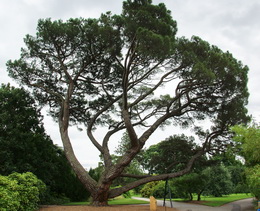
How Big Is It? When the first thing you encounter inside the gate is the tram that tours the garden making some 8 stops, you look at the map you have been handed and see that Kew is about 132 ha, (300 acres). Okay so it is going to be a long day and we are going to have to make choices. We forgo the tram and start walking. I love trees and Kew Gardens has an amazing collection of trees and since it has been a garden from mid 1700's many of them are impressively old and large. A fascinating Stone Pine Pinus pinea simply forces you to stop and examine its bark and size and to read about its history. This Pine like many of the trees here have a well documented history.
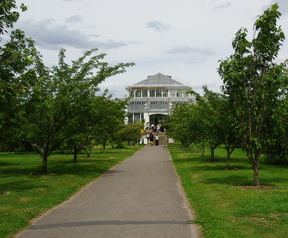 Relaxing While Exhausting! There are some intensively gardened sections at Kew Gardens but there are also huge expanses of treed lawn that are very refreshing after the several days of high interest/impact gardens that we have been visiting. The newest feature is a sizeable elevated walkway that wanders, after you have climbed the long stairs, through the canopy of some of the magnificent trees. A very different perspective on mature trees, particularly when the wind blows and the walkway and the trees sway in unison. Typical of old, well designed English gardens is the attention that was given to vistas. Long sight lines through the park that draw your eye down a column of trees or a hedge to a feature at the opposite end. This row of Japanese Cherry trees leads to one of the several glasshouses dotting the grounds of Kew Gardens. Some of these buildings have also been here for a long time and they house some very large palms such as the Chilean Wine Palm in this temperate house. At 16 m high, it is touted as the worlds tallest indoor plant.
Relaxing While Exhausting! There are some intensively gardened sections at Kew Gardens but there are also huge expanses of treed lawn that are very refreshing after the several days of high interest/impact gardens that we have been visiting. The newest feature is a sizeable elevated walkway that wanders, after you have climbed the long stairs, through the canopy of some of the magnificent trees. A very different perspective on mature trees, particularly when the wind blows and the walkway and the trees sway in unison. Typical of old, well designed English gardens is the attention that was given to vistas. Long sight lines through the park that draw your eye down a column of trees or a hedge to a feature at the opposite end. This row of Japanese Cherry trees leads to one of the several glasshouses dotting the grounds of Kew Gardens. Some of these buildings have also been here for a long time and they house some very large palms such as the Chilean Wine Palm in this temperate house. At 16 m high, it is touted as the worlds tallest indoor plant.
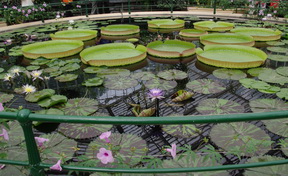
Old and Cute! No not yours truly but the waterlily house. It is a tiny glasshouse that was built in 1851, specifically to house a large water lily, Victoria amazonica These amazing lilies have leaves up to 2m across but they did not thrive in this little house. New hybrids developed at Longwood gardens in the 1960s were easier to grow and this delightful little gem of a glasshouse once again is used for its original purpose. Another feature that we searched for was the Wollemi Pine that was noted on the map. We eventually found this 2.5 tree completely enclosed by a heavy metal barrier and my traveling companion, known to all as the assistant gardener, pronounced that she was mightily unimpressed. Unless you are aware of the history of this little tree, it really was unimpressive as a specimen. I can now say that I have actually seen this fascinating plant and was prevented from buying one in the Kew Gardens shop both by its price and my inability to transport it back to Canada. It would probably not be hardy here anyway.
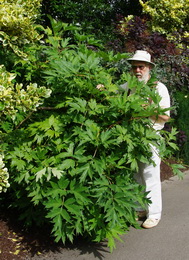
What Can I Learn? As the day and our feet wore down we started to find some of the more intensive gardens. There were large teaching and research gardens that were in transition, (aka empty,) during our visit and some impressive perennial beds where plants that we are familiar with as small specimens appear as 2m tall giants. A couple of peonies, such as the Peony Lutea that I am admiring, though not in flower, were impressive just because of their size. One perennial bed is, however, much like another after you have been touring gardens for a few days.
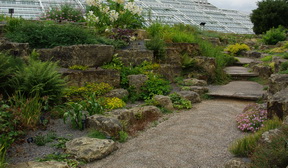
Hidden Treasures! Tucked away in a back corner of Kew Gardens was an area simply noted on the map as “rock garden.” These are the treasures that make garden touring exciting. A long and meandering path through an extensive and interesting garden with massive planted rock walls created a feeling of separation from the rest of the world. A continuous stream that cascaded through them at various points made this a refreshing delight at the end of a long day. We were able to just sit and take in the many species of plants that were being used in some very creative ways to produce a delightful display. This being Kew, of course it was also educational because almost everything was labeled. Pictures and notes were recorded in the vain belief that we might be able to replicate some of this back in our less hospitable climate. I’m already planning the remake of one corner of the garden to incorporate some of these ideas.
I can no more report on our visit in one web page than we could do a realistic visit of this whole garden in one day but hopefully I have given you an overview of the delights that await your visit to Kew Gardens. The pub at the tube station was a very welcome site as we started our trek back to the hotel.
